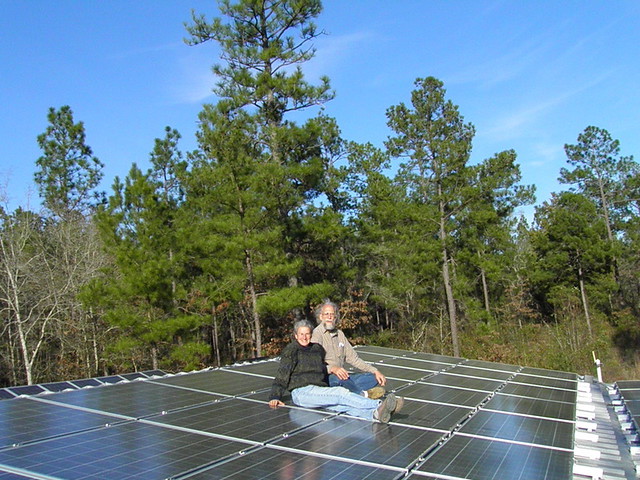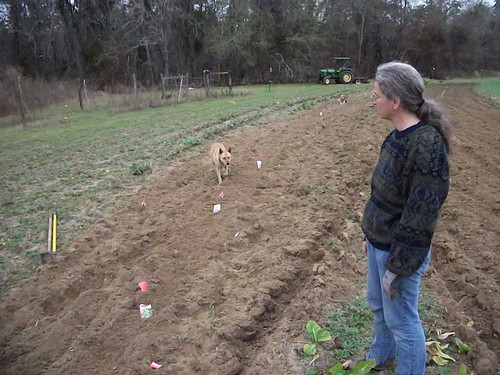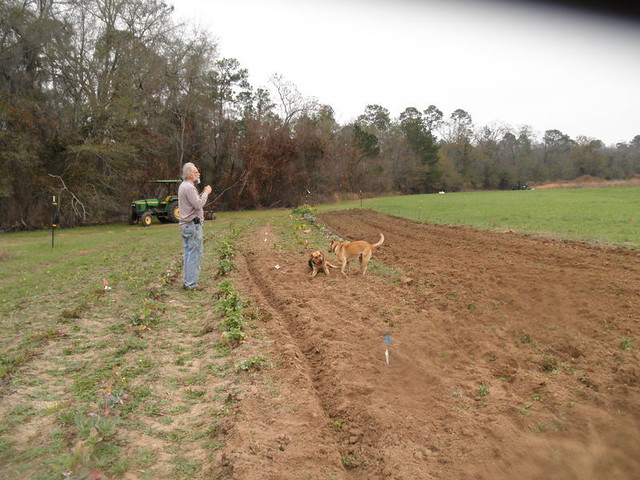High and higher:
Lowndes County, Georgia, 7 March 2012.
Pictures by Gretchen Quarterman for Okra Paradise Farms
Closeup:
Continue reading
High and higher:
Lowndes County, Georgia, 7 March 2012.
Pictures by Gretchen Quarterman for Okra Paradise Farms
Closeup:
Continue reading

Photo CC BY-ND Okra Paradise Farms
You can see the old panels sticking up on the left, and we’re sitting on some of the new panels, which continue on the lower roof on the right.
 These panels were purchased with the assistance of a
USDA Rural Energy for America Program (REAP) 25% grant:
These panels were purchased with the assistance of a
USDA Rural Energy for America Program (REAP) 25% grant:
Eligible projects include those that derive energy from a wind, solar, biomass, or geothermal source, or hydrogen derived from biomass or water using wind, solar, or geothermal energy sources.The REAP program will probably be renewed this year, so if you have a farm, you could apply.
 We also applied for and got a
We also applied for and got a
 U.S. Treasury 30% grant from the
1603 Program: Payments for Specified Energy Property in Lieu of Tax Credits.
That program was funded by the
The American Recovery and Reinvestment Act of 2009 (Recovery Act).
U.S. Treasury 30% grant from the
1603 Program: Payments for Specified Energy Property in Lieu of Tax Credits.
That program was funded by the
The American Recovery and Reinvestment Act of 2009 (Recovery Act).
Finally, there is the Georgia Environmental Finance Authority (GEFA) 35% Clean Energy Property Tax Credit, which will apply in parts over four years.
That all adds up to 90% covered by grants and tax credits, which is a pretty good deal.
Now that remaining 10% is still a significant amount;
like the price of a small car.
But in 7-15 years (how long it will take to pay off this system,
depending on how you figure it),
what would
 the value of a car be?
Much less than when you bought it.
Meanwhile, these solar panels will be generating almost as much
power as they are now, and they will continue to generate for
at least a decade more, probably much more.
the value of a car be?
Much less than when you bought it.
Meanwhile, these solar panels will be generating almost as much
power as they are now, and they will continue to generate for
at least a decade more, probably much more.
The big missing piece is up-front financing. For more on that, see other blog post.
Meanwhile, we have here on our workshop roof a proof of concept, operational right now.
The little dogs wanted to know what we were doing on the roof: Continue reading
Panning around their habitat, you can’t see them, but you can hear them.
Here’s a playlist: Continue reading
A small lily that grows only in counties along the Georgia-Florida border, and maybe in a few in Alabama: Treat’s Rain Lily, Zephyranthes atamasca var. treateiae. These days it’s classified as an amaryllis.
-jsq
Here’s a slideshow: Continue reading

by John S. Quarterman, Lowndes County, Georgia, 6 February 2012.
Not digging, she hopes? We just planted potatoes there! Here’s a slideshow: Continue reading
 Back in December
Back in December
 we burned some planted longleaf.
Six weeks later, they’re greening up and candling.
I couldn’t find a single longleaf that didn’t survive.
Even ones that a few weeks ago you would have thought
were burnt sticks now have green leaves or white candles
or both.
we burned some planted longleaf.
Six weeks later, they’re greening up and candling.
I couldn’t find a single longleaf that didn’t survive.
Even ones that a few weeks ago you would have thought
were burnt sticks now have green leaves or white candles
or both.
Here’s a slideshow.
Pictures by John S. Quarterman 29 February 2012.
-jsq


 Fortunately these vines were mostly in
invasive exotics anyway
(chinaberry, mimosa, Japanese privet) that had grown up along the field edge.
After a few minutes,
here’s the result.
Fortunately these vines were mostly in
invasive exotics anyway
(chinaberry, mimosa, Japanese privet) that had grown up along the field edge.
After a few minutes,
here’s the result.
Most of the rest of the woods burned much more evenly, with flames only a foot or two above the ground.
Dig, dogs, dig!

Lowndes County, Georgia, 6 February 2012.
Like this: Continue reading